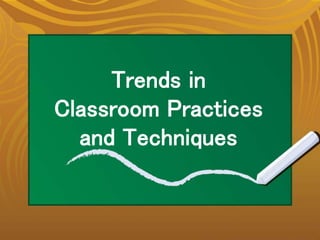
Trends in Classroom Practices and Techniques
- 1. Trends in Classroom Practices and Techniques
- 2. Copying: The First Step • Teachers are one in recommending that for beginners, the starting point in their writing program is the basic sentence pattern. • After several practice exercises on sentence copying, the pupils advance to copying paragraphs, dialogues, short conversations, and lines or stanzas of poetry. • The major concerns in every copying activity are legibility and accuracy.
- 3. Mastery of the following rules by beginners is considered an important writing foundation: CAPITALIZATION 1. Every sentence begins with a capital letter. 2. The personal pronoun I is always written as a capital letter. 3. Proper nouns begin with a capital letter; abbreviation of proper nouns are capitalized. 4. Most adjectives derived from proper nouns begin with a capital letter.
- 4. 5. Every title attached to the name of a person is capitalized. 6. Every line of poetry begins with a capital letter. 7. The first word of a direct quotation is capitalized. 8. All names that refer to God and the names of all sacred books are capitalized. 9. The first word and the other words in tiles of books, poems, stories, and compositions, except articles, conjunctions, and prepositions are capitalized.
- 5. 10. The names of definite geographical parts of a country begin with capital letters. The words: north, south, east, west, when used merely to indicate direction do not begin with a capital letter. 11. Father, mother, uncle, aunt, cousin, and other words which show personal relation do not begin with capital letters unless they are used as a part of a proper name. 12. The names of the days of the week, the months of the year, holidays, but not the names of the seasons, are capitalized.
- 6. 13. The names of the school subjects are not capitalized unless they are proper nouns or proper adjectives. 14. The first word, including the nouns, in the salutation of a letter begins with a capital letter. 15. The first word of every part of an outline is capitalized.
- 7. PUNCTUATION 1. A period is used (.): After a complete declarative and imperative sentence. After an abbreviated word or a single or double initial letter representing a word. 2. A question mark (?) is used after a direct question. 3. An exclamation point (!) is a mark used to show a forceful way of speaking or a strong feeling.
- 8. 4. A comma is used (,): to separate words in a series to separate the parts of addresses, dates, geographical names to set off a noun used in direct address to set off yes, no from the rest of the sentences To set off quotation expression such as he said, he says, etc
- 9. PARAGRAPHING 1. The beginning of a paragraph is shown by the indention of the first word. 2. Indent the first word of all paragraphs the same distance from the margin. 3. In a story, a direct quotation requires a separate paragraph. 4. In a dialogue, the exact words of the speaker should be written in a separate paragraph in order to make clear the change of speaker. 5. Begin a new paragraph for each new division of thought.
- 10. DICTATION • In ordinary practice, the teacher uses a short passage of one or two paragraphs, with a vocabulary and sentence structure appropriate for the grade level of the pupils. It may be a simple prose, a short tale, or a dialogue. Before the class starts, the teacher lists on the board those words in the passage, the meaning of which the pupils cannot be expected to know.
- 11. • The teacher reads entirely the passage at a normal speed with normal intonation while the pupils listen. She then reads the passage in short phrasal segments for the pupils to write down. The phrases should be short, enough for the slowest pupils to understand.
- 12. • After the pupils have written the passage from dictation, the teacher rereads the passage while the pupils go over their written work. The teacher may call on pupils to read some of the sentences in the dictated passage and finally on one pupil to read the entire passage.
- 13. • The teacher then collects and marks the written work of pupils. She may also allow the pupils to correct their own work by refereeing them to the original passage. At other times, she may resort to peer correction of the papers.
- 14. THE DICTO-COMP Combination of a dictation exercise and composition writing activity. Steps: 1. The teacher reads the passage once in its entirely at a normal speaking pace; the pupils may take down notes while listening to the passage being read. 2. The teacher reads the passage for a second time slowly, while she lists on the blackboard the words such as proper names, nouns, verbs, adjectives, adverbs or content words.
- 15. 3. An outline of the passage may be made and written on the blackboard after the first reading. The outline is supplied by the pupils. 4. While the pupils are writing, the teacher goes around the room correcting and commenting or making suggestions. 5. On-the-spot or in-class correction is done after the pupils have finished writing. Two ways of correcting are followed; self correction or peer correction.